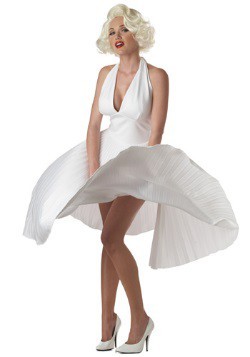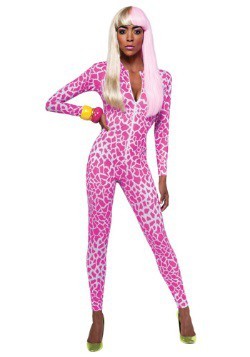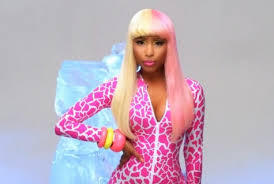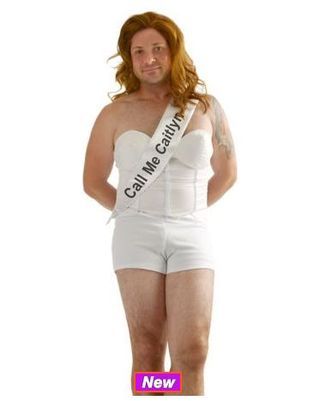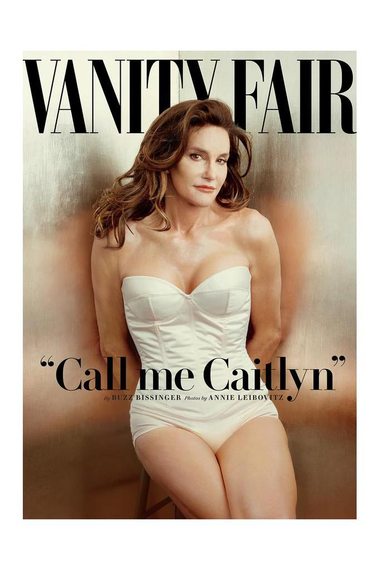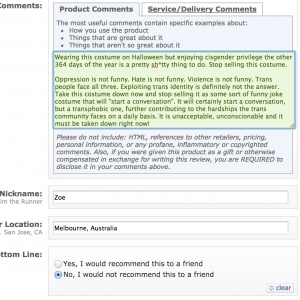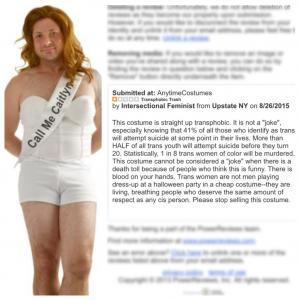Let's play a little game. Who does this costume represent?
Yep, it's a costume of Marilyn Monroe.
Okay. How about this? Who's this a costume of?
Duh. We know you know. Obviously that's a costume of Nicki Minaj.
OK, one more. How about this one?
You guessed it! It's Caitlyn Jenner!
Notice anything? Yeah, we did too.
The Marilyn Monroe and Nicki Minaj costumes all have something in common: the model's presentation in the advertisement matches the celebrity's presentation in real life. Same amount of body hair, same amount of makeup, same overall aesthetic.
The Caitlyn Jenner costume? Not so much. The real-life Jenner, in all of her Vanity Fair cover glory, wears makeup, has no excess body hair in sight and fits the notion of binary femininity (that is, the expression of gender many people associate with the words feminine and women).
The model donning her costume fits the notion of binary masculinity (the expression of gender many people associate with the words masculine and men) -- excess body hair, no visible makeup and an uncomfortable smile more reminiscent of a friend losing a bet to wear a corset than Jenner's fierce stare of unapologetic realness.
When this costume (and the masculine model wearing it) was released, Twitter went wild. Young people who are socially aware as to why this image was so problematic were ranting, in 140 character snippets, about how something needed to be done about it. Having just completed our #ReadyForFreddie text, in which one of our DoSomething.org staffers came out as trans via text to 2.4 million young people, we knew we had to be the platform for young people to take action around an instance of transphobia.
We launched the 1 Star for Hate: Transphobia campaign the same day it was put on our radar, August 25, 2015. This campaign asked members to give this costume a one-star review and leave a comment demanding it be taken down. We provided our members with sample text and links to the websites hosting this costume with a masculine model. Here's an example:
"Wearing this costume on Halloween but enjoying cisgender privilege the other 364 days of the year is a pretty sh*tty thing to do. Stop selling this costume" - Zoe, Australia
Other members wrote their own reviews, which we were even stronger than we could have imagined.
This costume is straight up transphobic. It is not a 'joke,' especially knowing that 41 percent of all those who identify as trans will attempt suicide at some point in their lives. More than HALF of all trans youth will attempt suicide before they turn 20. Statistically, 1 in 8 trans women of color will be murdered. This costume cannot be considered a 'joke' when there is a death toll because of people who think this is funny. There is blood on your hands. Trans women are not men playing dress-up at a halloween party in a cheap costume -- they are living, breathing people who deserve the same amount of respect as any cis person. Please stop selling this costume.
By September 22, less than one month later, the two retailers (Wholesale Halloween Costumes and Anytime Costumes) our members targeted with over 160 comments removed the costume and its masculine-presenting model.
While those two retailers removed the costume, it should also be noted that Spirit Halloween, which manufactured the costume, has always advertised it with an image that matches Caitlyn's gender expression. We at DoSomething.org are proud to applaud Spirit Halloween for that and believe that the current model and advertisement of this costume truly does honor Caitlyn.
Our members spoke out against this costume and won. Great! But why is transphobia -- in this instance and in others -- such a huge issue that needs our attention?
The model was switched. The costume was removed from those two sites, so transphobia is over, right? Wrong. We knew this issue ran way deep when people were backlashing, stating that calling this costume "transphobic" was blowing it out of proportion, that Jenner is a celebrity, so costumes come with that territory. We also knew that sites selling this costume believed it was "honoring" Jenner and her Vanity Fair debut. Caitlyn herself stated that she thought the costume was "great." We had to take a step back here at DoSomething.org and ask ourselves, were we providing our members the platform to make real change, or just nag websites?
Let's rewind. In July we launched a campaign called Nude Awakening, which gave members the tools to target Merriam-Webster Dictionary's narrow definition of "nude": having the color of a white person's skin, according to them. Our members, our interns and our staff knew that this narrow definition perpetuated the idea that white skin is the "right" skin. After flooding Merriam-Webster with our comments, they changed the definition! We knew giving our members the chance for their voices to be heard could make real change, as Nude Awakening showed. So why did that campaign receive so much less backlash than 1 Star for Hate: Transphobia did? We knew there was something here that wasn't quite translating the way we knew it needed to for impact to occur.
Well, celebrity costumes are often made to do one of two things: honor a celebrity or poke fun at them (they're in the spotlight, so what should they expect, amirite?). I'm thinking of the DIY rockstar costumes, which encourage people to attach fake piercing to their faces and adhere temporary tattoos onto their arms. Or the outdated pink hair clip-ins to match the 90s popstar aesthetic of X-tina and Britney. Unlike the Jenner costume, these are generally regarded as hilarious, with only a few people finding them offensive (usually the diehard fans, tbh). So, what was the difference between that and the Caitlyn costume?
The answer is incredibly simple: women aren't being killed for their body mods or their hair color. Women are being killed, however, for their trans identity.
As of today, October 7, 2015, at least 19 trans women have been murdered in the United States this year alone. That number is higher than the total number of trans people murdered in all of 2014, and we still have a quarter of 2015 to go. Of these 19 victims, at least 15 were trans women of color. These deaths are directly a result of transphobia, which Oxford defines as the intense dislike of or prejudice against transsexual or transgender people. In areas across the US, from rural Alabama to the streets of NYC, trans women, specifically trans women of color, are constantly targeted for who they are.
If you leave this blog post learning one new thing, it's the term passing privilege. This means exactly what it sounds like: having the privilege to pass as a certain identity based on what society attributes to said identity. Think back to the pictures above of Caitlyn's costume versus her actual Vanity Fair cover. Caitlyn's gender presentation exists in the binary, and she has the privilege to present her gender in a way she feels "fits." She has the money, general social support and overall security from street harassment and violence to ensure her physical presentation matches what we were raised to associate with the words feminine and women.
It should be noted that many trans and gender-expansive people denounce the notion that historically binary gender expression should equate to gender validity (for example, if a trans woman chooses to grow out facial hair, she should still be regarded as a woman, with feminine pronouns, etc.). This, however, is not the case here. By no means was this masculine-presenting model a stance against the patriarchy that stifles our gender presentations to a checklist of femininity vs. masculinity. If it were, we might have just applauded these retailers instead of targeted them.
Instead, this costume was an underhanded microaggression that welcomed misunderstandings and stereotypes of trans women with open arms: that transgender women are just cisgender men in drag.
Jenner may have stated that she thought the costume was "great," but she also has the privilege to be removed from the reality of being a trans woman walking down the street, simply existing on any given day. She also has the privilege to be white, wealthy and to come out on her own terms. She has stated herself that she has a lot to learn about the community for which she is now a voice, and she has a long way to go. This all comes with her recognizing her privilege.
Until trans people are seen as equal to cis folks, misgendering, via pronoun or presentation, will continue to be an act of transphobia and an act of violence. Our members took a stance against that violence and achieved a real victory, and our campaigns will continue to provide them a voice and a platform to effect more change.
Want to speak out against other offensive costumes this Halloween? Sign up for our 1 Star for Hate campaign to flood online retailers with one-star reviews of racist costumes.
Sam Arpino runs the sex, violence and relationships campaigns at DoSomething.org. She is an intersectional feminist from Brooklyn who enjoys dismantling societal misperceptions, one social construct at a time.

